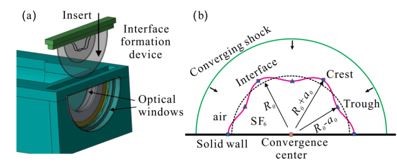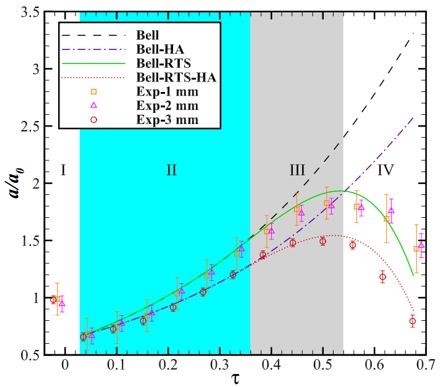Recently a breakthrough in instability of fluid dynamics interfaces has been made by Prof. LUO Xisheng and Prof. LU Xiyun’s team of the School of Engineering Science, the University of Science and Technology of China (USTC). It reveals for the first time that there is attenuation before the reverberated shock wave effect and successfully proves the existence of Rayleigh-Taylor stability resulted from deceleration of different-density interfaces upon the effect of converging shock wave. The findings provide insight in improving fluid dynamics interfaces instability, thus potentially benefits applications in inertial confinement fusion, supersonic combustion, sophisticated weapons in defense, astrophysics.

Figure 1.Instability of fluid dynamics interfaces in inertial confinement fusion (Image from Betti R. & Hurricane O. Nature Physics, 12(5):435, 2016)
Induced by shock wave, the instability of fluid dynamics interfaces involves complicated multi-scale and strong non-linear physical problems. As a main branch of research in the mechanism of incompressible turbulence as well as high-energy density physics, it can be broadly applied in inertial confinement fusion, supersonic combustion, sophisticated weapons in defense, astrophysics, etc.
In experiments, common methods like laser inertial confinement fusion generally consume tons of time and money and are difficult to diagnose and be operated on a large scale. Thus the converging shock-induced instability of fluid dynamics interfaces has always been a hot spot and a tied knot. After several years of research, group members conquer the key techniques to generate converging shock wave and form controllable interfaces, so as to continue their work on converging shock wave-induced instability of interfaces(Phys. Fluids 27: 097102, 2015).

Figure 2. (a) semiannular interface formation device and test section
(b) interaction between cylindrical converging shock and the interface (Image by LUO Xisheng)
Recently, with a crafty experiment design the interaction between converging shock wave and gases has been achieved and the growth of the disturbance amplitude has been measured for the first time. According to this a disturbance growth model has been proposed whose results in theory correspond well to the experimental ones. It is discovered that the development of the interface disturbance can be divided into four phases: compression phase, accelerated growth phase, decelerated growth phase and amplitude attenuation phase. Such findings reveals the internal mechanism of converging shock-induced instability of interfaces and provides solid data for theoretical and numerical research. It also helps understand the complicated physical process in such a field. “The article presents a high quality data set using an innovative experimental arrangement and provides an interesting analysis.”said reviewers of the paper.

Figure 3. Time-dependent curve of disturbance upon converging shock: legends stand for results with different initial amplitude; dash for Bell curve in theory; dash-dot for modified Bell curve in theory with large amplitudes; full line for Bell curve in theory taking Rayleigh-Taylor effect into account; dot for modified Bell curve in theory with large amplitudes taking Rayleigh-Taylor effect into account
Ⅰ:compression phase;Ⅱ:accelerated phase;Ⅲ:decelerated phase;Ⅳ:amplitude attenuation phase (Image by LUO Xisheng)
The paper entitled ‘Measurement of Richtmyer-Meshkov Instability at an Air-SF6 Interface in a Semiannular Shock Tube’ was published on Phy. Rev. Lett. This work was funded by National Research Foundation for Outstanding Youth, National Research Foundation for Innovative Research Group, Postdoctoral Foundation and Challenge Project of Physics Institute of Chinese Academy of Sciences.
Paper link:https://doi.org/10.1103/PhysRevLett.119.014501
Contact: Prof. LUO Xisheng
E-mail: xluo@ustc.edu.cn
Lab site:http://staff.ustc.edu.cn/~xluo/